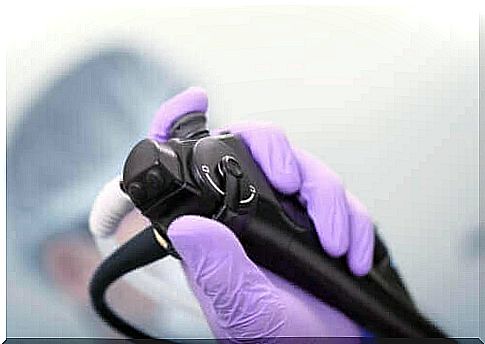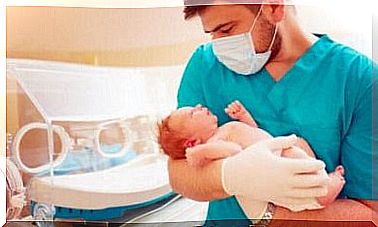What Is A Bronchoscopy And What Is Its Purpose?

A bronchoscopy is a diagnostic test that doctors have used since the late 1800s. It shows the airways up to the largest bronchi. In addition, it can also be used to treat certain pathologies.
This technique has improved significantly over time. Doctors initially conducted the study using a rigid steel tube. Today, however, they use a smooth and flexible tube that is much easier to handle.
Bronchoscopies are one of the fundamental pillars of pulmonology and are very commonly used to retrieve certain information. That is why in this article we explain everything you need to know about the technique and how it is performed.
What is a bronchoscopy?
A bronchoscopy, as we indicated in the introduction, is a procedure that allows the visualization of the airways. Doctors perform this examination to diagnose or treat certain respiratory diseases.
They use a bronchoscope for this. This is a tube about 60 centimeters long and is inserted through the mouth. This tube has a camera on the end that allows you to see the inside of the airways by showing on a screen what the camera is recording.
In addition to a camera, the bronchoscope allows doctors to bring other tools into the area. For example, to take tissue samples or to remove a foreign object from the airways.
Currently, the flexible bronchoscope with camera is most commonly used. It can reach less accessible parts of the bronchi and allows more movement.
However, doctors still use the rigid bronchoscope in certain situations. Especially in cases of bleeding or when there is a large foreign body in the airway. Before the rigid bronchoscope is inserted, the patient is first placed under general anesthesia.
What are the indications for a bronchoscopy?
Bronchoscopies are tests that doctors often use to diagnose possible lung diseases. This is why they usually perform it in people with respiratory symptoms such as:
- cough
- difficulty breathing
- signs of infection
It is generally used when other diagnostic tests have failed to find the cause of the underlying pathology. In addition, it is important to emphasize that it is also a therapeutic tool. The main indications for this include:
- Remove obstructive foreign bodies from the airways.
- Sampling of lung or bronchial tissue: This is helpful in identifying the cause of an infection or in making a histological diagnosis.
- Diagnosis of cancer: According to a study published in the Cuban Journal of Military Medicine , the best time to perform a bronchoscopy is when doctors suspect cancer.
- Stopping bleeding: by means of laser or electrocautery techniques.
- To enlarge airways that may be narrowed.
How does the procedure work?
A bronchoscopy is not a very pleasant technique for the patient. The procedure itself usually takes between half an hour and an hour. It also requires time for preparation and subsequent recovery time. The total time is therefore considerably longer.
To avoid complications and discomfort to the patient, doctors perform rigid bronchoscopies under general anesthesia. In other cases, doctors only administer sedatives for mental calm and muscle relaxation.
Usually the patient lies on a stretcher or operating table. Heart rate and oxygen levels should be monitored at all times while performing this exam. The doctor or endoscopy expert can insert the bronchoscope through the mouth. This is done slowly and carefully, avoiding sudden movements.
In some cases, another tube is also inserted through which a saline solution is administered. This clears the mucus in the airways and allows doctors to obtain better tissue samples. Sometimes, as we mentioned before, the doctors introduce stents to keep the airway open.
Once they have accomplished the purpose of the procedure, the doctors must remove the bronchoscope. To do this, they gently pull the tube and remove it bit by bit.
Recommendations before undergoing a bronchoscopy
In most cases, this is a scheduled procedure that is often done on an outpatient basis. Therefore, for the preparation it is important to take into account all the recommendations of the doctor.
- In general, patients taking blood thinners should avoid anticoagulants for a few days before the procedure because it is a procedure with a small risk of bleeding.
- Patients should report to the hospital with a trusted person at their side in comfortable clothing.
- While not all cases require general anesthesia, the medication to calm the patient can make them drowsy and dizzy. We therefore recommend that someone supervise the patient after surgery.
During the procedure
In most cases, no general anesthesia is needed, so the patient undergoing this examination is usually awake and can help the doctors do their job. This allows the doctor to ask questions.
After the procedure
After the bronchoscopy, it is important to rest for some time and remain under the supervision of a nurse. In the hours after the examination, complications such as bleeding may occur in certain cases. It is therefore essential that the patient remains under observation for some time.
In addition, the effect of the anesthetics decreases during this period. Usually around this time the patient will begin to feel discomfort and numbness in the throat. Doctors also recommend that you do not eat or drink anything in the hours following the bronchoscopy. This advice is intended to prevent choking.
Most people experience some sore throat or cough afterwards. However, if the patient has difficulty breathing, is coughing up blood or has a fever, it is imperative to see a doctor.
Risks of Undergoing a Bronchoscopy
Like any other medical procedure, this research also carries certain risks. However, complications are rare (Spanish link). In fact, these usually stem from the anesthesia rather than the technique itself.
Children often undergo bronchoscopies. This is because it is common for them to swallow small objects that get stuck in the airways. In addition, it is important to emphasize that, according to a study published in Pediatric Surgery, experts consider this technique to be safe and with great diagnostic cost-effectiveness at that stage of life.
According to the Mayo Clinic, the possible risks of this procedure include bleeding, a collapsed lung and fever. Bleeding is usually self-limiting: it tends to resolve on its own. A collapsed lung can occur when the bronchoscope pierces a piece of the lung and air collects around the lung.
Bronchoscopies are an essential technique in pulmonology
Bronchoscopies are relatively simple examinations that offer great diagnostic and therapeutic benefits. This procedure rarely causes complications, and in most cases, doctors perform it without a general anaesthetic.
It is one of the most important techniques when it comes to cancer diagnosis. It is also very useful in pediatrics as children often ingest small objects that get stuck in their airways. In addition, bronchoscopies allow doctors to perform more and more treatments.









